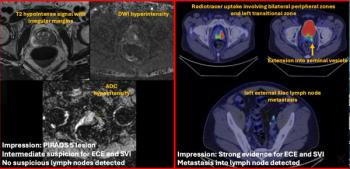
Siemens’ Definition AS redefines CT
Siemens Medical Solutions unveils a new CT platform this week at the RSNA meeting that company executives claim will put an end to the slice wars vendors have been fighting since the first multislice scanners were commercialized eight years ago.
Siemens Medical Solutions unveils a new CT platform this week at the RSNA meeting that company executives claim will put an end to the slice wars vendors have been fighting since the first multislice scanners were commercialized eight years ago.
"This is not just about a scanner with more detector rows," said Peter Kingma, Siemens vice president for CT. "We truly want to distance ourselves from detector rows as a technological or clinical positioning tool."
The German company's new Definition AS (Adaptive Scanning) is currently a work-in-progress but is slated to begin shipping in May 2008. It bears the class name of Siemens' dual-beam scanner, unveiled two years ago, even though it uses only a single x-ray beam. It does, however, incorporate other advanced technologies found in the Definition platform.
"This is a totally different system that has the DNA of the best-of-breed innovations we have brought out over the last 10 years," Kingma told DI SCAN. "But it is an absolutely new platform."
The scanner is called adaptive to make a point about its versatility, which is already apparent on the assembly line. Definition AS can be configured with 20, 32, or 64 detector rows. Siemens' z-Sharp technology doubles the slice number per rotation while its Stratton x-ray tube narrows the focal spot. Together, the technologies deliver spatial resolution of 0.24-mm pixels.
The scanner provides unprecedented temporal resolution, according to Kingma. The gantry rotates every 300 msec, faster than the previous industry benchmark of 330 msec. A 30-mega heat unit x-ray tube offers continuous dynamic cooling, which allows the system to run at the highest power levels necessary to visualize any clinical target, he said.
Adaptive 4D Spiral uses synchronized table movement to cover up to 27 cm by shuttling its 64 detector rows across a whole organ--such as the brain--to record blood perfusion. This shuttling is achieved as the table moves the patient back and forth inside the gantry, automatically and constantly varying the pitch.
"The patient is almost unaware of the changes in direction," Kingma said.
A high-power generator, capable of producing up to 100 kW, produces high-quality, dynamic images even on bariatric patients, who can now be supported by the CT's new 650-pound-capacity table and 78-cm wide-bore gantry.
"Combine the demands of bariatric and cardiac imaging in one examination and you can see that the added power is advantageous to the clinician," he said.
The faster gantry rotation as well as a new dose-reduction technique employing an intelligent collimator keep patient dose in check. Siemens engineers have blocked the amount of radiation the patient receives during the first and last 180º of rotation of the exam. These two half-rotations provide no diagnostically useful data, according to Kingma. Blocking them cuts radiation dose to the patient by 10% or more, he said.
Newsletter
Stay at the forefront of radiology with the Diagnostic Imaging newsletter, delivering the latest news, clinical insights, and imaging advancements for today’s radiologists.




























